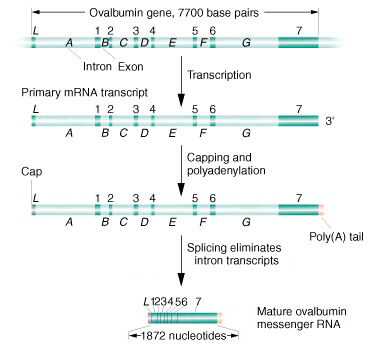
An important note on
terminology: Splicing of Exons &
Introns
'Splicing' is by defined the joining
of two things, for example the ends of two ropes. It is not
'splitting',
which is separating two things. However, in
molecular biology, ''splicing out' refers to the removal
of some RNA segments
in the process of splicing together the remaining
segments.
'Exon' and
'intron' by definition refer
to regions of the DNA
that are respectively "expressed" and "intervening."
However, these terms are sometimes used loosely to refer to
the corresponding sequences in hnRNA that
are retained or removed, respectively, from
the final mRNA product.
These should properly be called intron & exon transcripts,
as in the above diagram. This means of course that the
sequences of the DNA exons in the sense strand are
identical to the corresponding
mRNA exon transcripts,
except for substitution of U
for T. Thus the
corresponding amino acid sequences can be either 'read' directly from the DNA sense strand,
or 'translated' from
the mRNA.
Avoid
use of splicing to mean splitting
of the hnRNA transcript. Avoid
thinking of exons as the translated
portions of the mRNA, while recognizing that the
word is often used incorrectly. In the figure above, the phrase "Splicing
eliminates intron transcripts" means that "Splicing,
by joining together the exon transcripts, results in the
elimination of intron transcripts," not that
splicing is the direct elimination of intron transcripts.
Figure ©2000 by
Griffiths et al. ; text
©2025 by Steven M. Carr